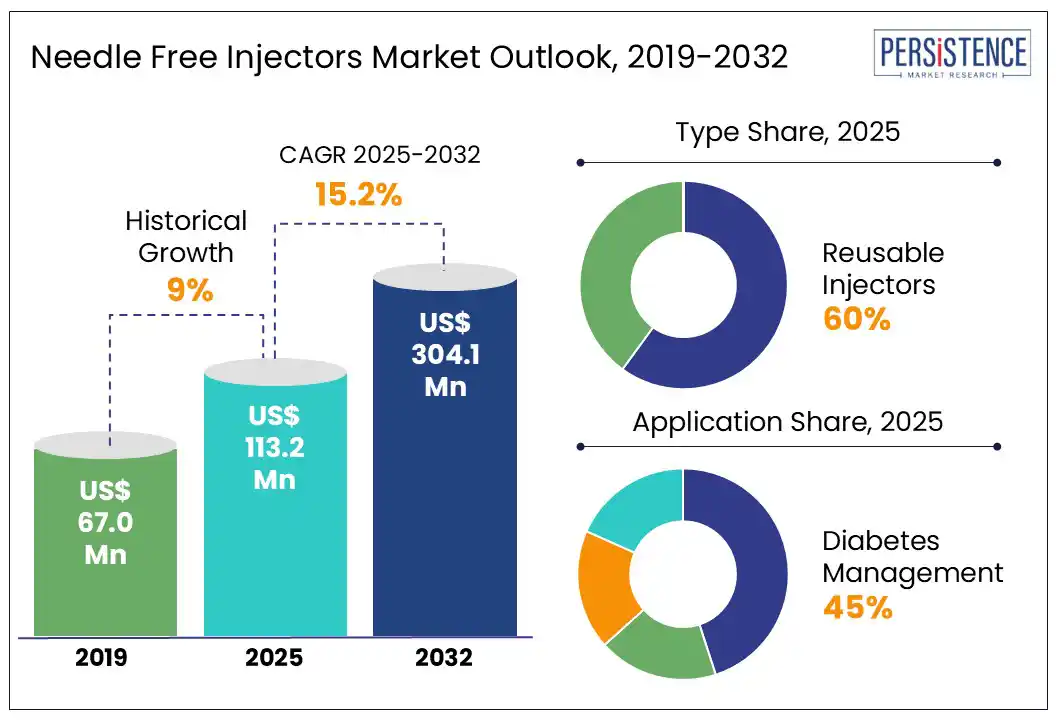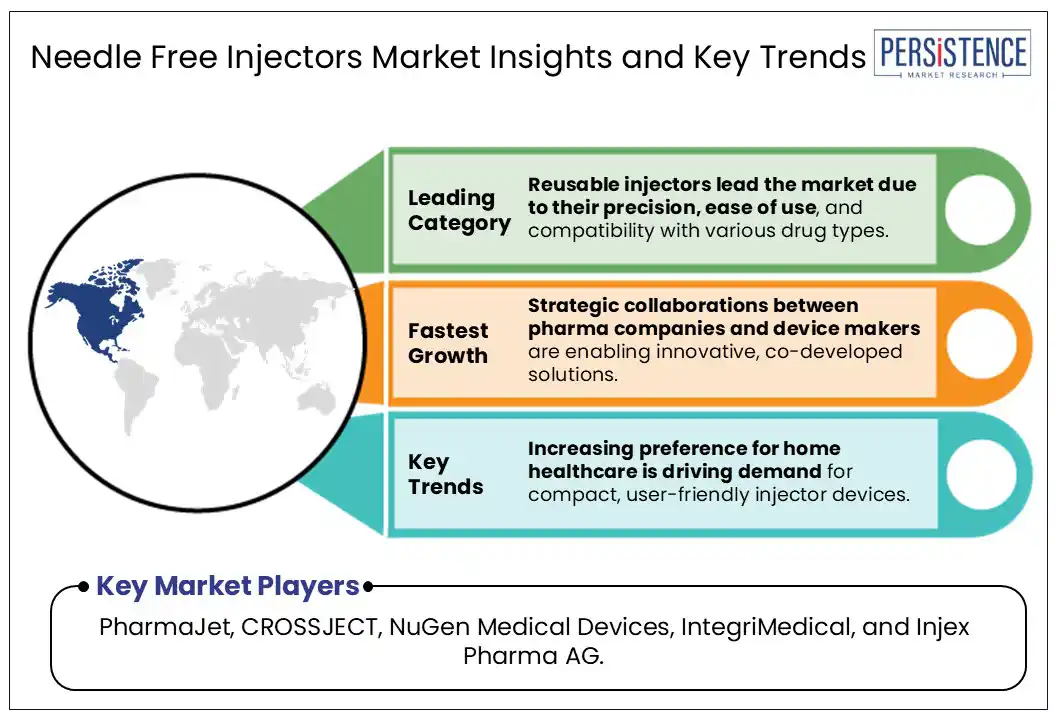ID: PMRREP35521| 199 Pages | 28 Jul 2025 | Format: PDF, Excel, PPT* | Healthcare

The global needle free injectors market size is likely to be valued at US$ 113.2 Mn in 2025 and is expected to reach US$ 304.1 Mn by 2032, growing at a CAGR of 15.2% during the forecast period from 2025 to 2032. The needle free injectors market growth is driven by increasing demand for pain-free drug delivery systems and rising awareness around safe and efficient injection technologies. These devices eliminate the need for traditional needles, reducing the risk of needle stick injuries and improving patient compliance, especially in chronic disease management and vaccination programs.
Technological advancements in jet injectors and spring-loaded systems are enhancing precision and usability, making them ideal for both clinical and home healthcare settings. Supportive government initiatives and the expansion of healthcare infrastructure in emerging economies are driving market growth. As pharmaceutical companies invest in innovative delivery methods, the market is poised for significant transformation and adoption across diverse therapeutic areas.

Key Industry Highlights:
|
Market Attribute |
Key Insights |
|
Needle Free Injectors Market Size (2025E) |
US$ 113.2 Mn |
|
Market Value Forecast (2032F) |
US$ 304.1 Mn |
|
Projected Growth (CAGR 2025 to 2032) |
15.2% |
|
Historical Market Growth (CAGR 2019 to 2024) |
9% |
The rising adoption of needle-free drug delivery systems is transforming patient care by offering a safer, more comfortable alternative to traditional injections. Healthcare providers increasingly prefer non-invasive injection technologies to reduce the risk of needle stick injuries and improve patient compliance. These systems are especially beneficial in chronic disease management, where frequent dosing is required. The growing demand for pain-free insulin delivery devices among diabetic patients is further accelerating market growth. Advancements in jet injector mechanisms are enhancing precision and reliability across various therapeutic applications.
Governments and health organizations are actively promoting needle-free vaccination solutions to improve immunization coverage and reduce cross-contamination risks. The surge in self-administration trends is driving innovation in compact, user-friendly injector designs suitable for home use. Pharmaceutical companies are investing in advanced needle-free injection platforms to enhance drug delivery efficiency and patient experience. As awareness of injection-related safety and comfort grows, the market is expected to witness sustained momentum across both developed and emerging regions.
High manufacturing costs of needle-free injection devices continue to limit their widespread adoption, especially in low-income healthcare settings. The complexity of precision drug delivery systems often requires advanced materials and engineering, which increases production expenses. Limited awareness and training among healthcare professionals also hinder the integration of non-invasive injector technologies into routine clinical practice. Moreover, the lack of standardized protocols for device usage and maintenance creates operational challenges in hospitals and clinics.
Regulatory hurdles further slowdown the approval and commercialization of novel needle-free injection platforms, especially in regions with stringent medical device laws. Concerns over dosage accuracy and drug compatibility with certain injector types affect their reliability in critical treatments. The limited availability of needle-free vaccine delivery systems in rural and remote areas restricts their public health impact. Without broader education and cost-effective solutions, market penetration may remain confined to select therapeutic areas and premium healthcare segments.
The growing demand for needle-free injection solutions for pediatric care presents a major opportunity for manufacturers to develop child-friendly, pain-free devices. As parents and healthcare providers seek safer alternatives for children, companies can innovate in design and usability. The expansion of needle-free drug delivery systems in emerging markets also opens new avenues, especially where healthcare access is improving rapidly. Rising investments in public health and immunization programs further support the adoption of these technologies.
The increasing focus on needle-free injectors for biologics and biosimilars offers scope for specialized product development. These drugs often require precise delivery, making advanced injector platforms highly valuable. The rise of home-based needle-free injection therapies is creating demand for compact, easy-to-use devices tailored for self-administration. As digital health integrates with drug delivery, smart injectors with tracking and feedback features could redefine patient engagement and treatment outcomes.
Reusable injectors are expected to dominate this category, accounting for over 60% of the market share in 2025. Their popularity stems from cost-effectiveness in long-term treatments such as diabetes, where frequent dosing is required. For instance, reusable jet injectors such as InsuJet and Injex30 are widely adopted among diabetic patients, allowing for multiple uses with replaceable nozzles and drug cartridges.
Disposable injectors are projected to be the fastest-growing segment. This growth is driven by increasing demand for hygienic single-use solutions in mass immunization programs and emergency care settings, especially in developing regions. Disposable injectors, while preferred for single-use scenarios such as vaccinations and emergency care, face limitations due to higher per-unit costs and waste management concerns. The World Health Organization (WHO) and PATH have actively endorsed disposable syringe jet injectors (DSJIs) in large-scale vaccination campaigns to minimize the risk of cross-contamination.
By application, diabetes management leads with a market share of around 45% in 2025. The global rise in diabetic patients and the need for frequent pain-free insulin delivery drive this dominance. Emerging applications in autoimmune disorders and pain management are gaining traction due to improved patient compliance and reduced injection-related anxiety, but they remain secondary in terms of revenue contribution. Devices such as InsuJet, ZomaJet, and PrimeJet Pro are increasingly used in insulin therapy, offering needle-free, self-administered solutions that improve adherence among insulin-dependent patients. Studies show that up to 70% of diabetic patients prefer non-invasive insulin administration if available, significantly enhancing long-term treatment compliance.
The vaccine delivery segment is expected to be the fastest-growing application area, fueled by global immunization drives, needle phobia concerns, and government initiatives promoting needle-free technologies for safer and more accessible vaccination. For example, the WHO and Gavi-backed campaigns are increasingly integrating devices such as PharmaJet’s Tropis for intradermal delivery of measles-rubella and inactivated polio vaccines.

North America continues to lead the global needle-free injectors market, accounting for over 35% of total revenue in 2025. The region benefits from advanced healthcare infrastructure, high awareness of needlestick injuries, and early adoption of innovative drug delivery technologies. The U.S. is the dominant force, with over 61% of hospitals integrating needle-free systems, particularly in pediatric and diabetic care. It also leads in clinical trials and product approvals, with companies such as PharmaJet and CROSSJECT actively launching new systems.
Canada shows steady growth, supported by public health initiatives and increasing adoption in homecare settings, especially for insulin and hormone therapies. Growth is supported by national immunization programs and increasing use of needle-free systems in rural healthcare. Canadian hospitals are integrating these devices into diabetes and hormone therapy protocols, with rising demand for reusable injectors.
Asia Pacific is the fastest-growing region, projected to expand at a CAGR of over 17% during the forecast period. Rapid urbanization, rising chronic disease prevalence, and expanding healthcare access are key drivers of this growth. China is making significant investments in public health infrastructure and mass immunization programs, with increasing adoption of needle-free vaccine delivery systems.
India is gaining momentum, especially after the Serum Institute of India acquired a 20% stake in IntegriMedical to advance needle-free injection technology. Japan and South Korea are also emerging as innovation hubs, with strong regulatory support and growing use of needle-free injectors in chronic care and cosmetic applications. Local manufacturing and favorable reforms across the region are encouraging broader market entry and expansion.
Europe maintains a steady growth trajectory, supported by robust regulatory frameworks and rising demand for pain-free drug delivery systems. Germany leads in the adoption of reusable injectors, particularly in the diabetes and hormone therapy segments. France is home to CROSSJECT, a key player expanding its ZENEO platform across emergency medicine and chronic care.
The U.K. is focusing on sustainability and reducing medical waste, which is driving interest in needle-free technologies across both public and private healthcare sectors. NHS programs are exploring needle-free technologies for pediatric and geriatric care, and reusable injectors are gaining popularity in homecare settings. The region’s emphasis on patient comfort, safety, and eco-friendly solutions continues to support the growth of needle-free injectors in clinical and homecare environments.
The global needle free injectors market remains moderately consolidated, with a few key players dominating global sales through proprietary technologies and strategic partnerships. Innovation, regulatory approvals, and geographic expansion are central to competitive positioning.
Companies are investing heavily in R&D for needle-free biologics delivery, aiming to capture the growing biosimilars market. Partnerships with pharmaceutical firms are enabling the co-development of drug-device combinations, improving therapeutic compatibility. Expansion into Asia Pacific and Latin America is a key focus, leveraging local manufacturing and regulatory support to boost adoption.
The needle free injectors market is projected to reach US$ 113.2 Mn in 2025.
The needle free injectors market is expected to grow to US$ 304.1 Mn by 2032.
Key trends include rising demand for pain-free drug delivery systems, growth in home-based self-administration, and innovations in needle-free biologics delivery platforms.
Diabetes management is the leading application segment, accounting for around 45% of the market share in 2025.
The market is expected to grow at a CAGR of 15.2% from 2025 to 2032, driven by technological advancements and expanding healthcare access.
Major players with strong portfolios include PharmaJet, CROSSJECT, NuGen Medical Devices, IntegriMedical, and Injex Pharma AG.
|
Report Attribute |
Details |
|
Historical Data/Actuals |
2019 - 2024 |
|
Forecast Period |
2025 - 2032 |
|
Market Analysis |
Value: US$ Mn |
|
Geographical Coverage |
|
|
Segmental Coverage |
|
|
Competitive Analysis |
|
|
Report Highlights |
|
|
Customization and Pricing |
Available upon request |
By Injector Type
By Application
By Delivery Site
By End-user
By Region
Delivery Timelines
For more information on this report and its delivery timelines please get in touch with our sales team.
About Author